Comprehensive Bibliometric Analysis on Smart Grids: Key Concepts and Research Trends
Abstract
:1. Introduction
1.1. Problem Statement and Rationale of the Proposed Work
1.2. Contribution of the Paper
- RQ1: What are the important keywords relevant to smart grid research?
- RQ2: Which keywords are mostly used and how do they co-occur with other keywords?
- RQ3: What is the annual production of articles from 2017 to 2022?
- RQ4: Which are the most relevant sources in smart grid research?
- RQ5: Which authors have published the most relevant articles on this topic?
- RQ6: Which are the most relevant and impactful affiliations?
- RQ7: How many annual country-collaborated publications are present in terms of country, affiliation, and author?
- RQ8: What is the country-wise scientific production in smart grid research?
- RQ9: What are the most cited countries in smart grid research?
- RQ10: Which countries conducted and collaborated on the most relevant studies on smart grids?
- RQ11: What are the most cited global documents in smart grid research?
- RQ12: Which keywords are mostly used and how they are related to other factors (authors, countries, etc.)?
- RQ13: What are the themes identified from smart grid research?
- RQ14: Which are the most popular topics explored and how they are related to other topics in different clusters?
2. Methodology
Extraction of Topic-Wise Title Count from Merged Dataset
3. Results and Discussions
4. Conclusions
- ▪
- Various themes/topics namely smart meter(s), demand response, clustering, residential buildings, machine learning, energy efficiency, Internet of Things, anomaly detection, big-data analytics, deep learning, energy consumption, and non-intrusive load monitoring are identified as key topics in smart grids research. It is also found that there is a strong connection between the keywords “smart grid”, “smart meter”, and “machine learning”. This implies that the selection of research topics as a combination of these keywords can lead to successful work. Further, the highest topic-wise title count (190) is identified with the keyword “energy consumption” and the next highest count (107) is identified with the keywords “smart meter readings” and “smart meter data” in the titles.
- ▪
- There is a gradual increment in the production of articles from 2017 to 2022. However, from the year 2021, there is a drastic change in the annual production with the highest production of articles (1150) found in the year 2021 and the next highest production of articles (925) found in 2022. This showcases the recent growing importance of smart grid research. Further, most of these research works are published in journals namely Energies and IEEE Transactions on Smart Grid with the numbers of documents being 132 and 102, respectively.
- ▪
- The most relevant authors identified from the analysis are Wang Y and Li Y. Similarly, the affiliations “Tsinghua University” and “North China Electric Power University” are identified as the most impactful affiliations with the number of articles 57 and 44, respectively.
- ▪
- This analysis reveals that China and the USA have occupied the top two positions with the production of articles, the numbers being 1423 and 566, respectively. Moreover, the highest number of single-country publications and the highest number of multiple-country collaborative publications on smart grids are from China. The second-highest number of single-country publications are from the USA. The second-highest number of multiple-country collaborative publications are from the United Kingdom. Moreover, the top two positions concerned with having the most citations are occupied by China (3020) and Australia (1279), respectively.
Author Contributions
Funding
Institutional Review Board Statement
Informed Consent Statement
Data Availability Statement
Conflicts of Interest
References
- Purna Prakash, K.; Pavan Kumar, Y.V.; Reddy, C.P.; Pradeep, D.J.; Flah, A.; Alzaed, A.N.; Al Ahamdi, A.A.; Ghoneim, S.S.M. A Comprehensive Analytical Exploration and Customer Behaviour Analysis of Smart Home Energy Consumption Data with a Practical Case Study. Energy Rep. 2022, 8, 9081–9093. [Google Scholar] [CrossRef]
- Purna Prakash, K.; Pavan Kumar, Y.V. Systematic Statistical Analysis to Ascertain the Missing Data Patterns in Energy Consumption Data of Smart Homes. Int. J. Renew. Energy Res. 2022, 12, 1560–1573. [Google Scholar] [CrossRef]
- Kasaraneni, P.P.; Yellapragada Venkata, P.K. Analytical Approach to Exploring the Missing Data Behavior in Smart Home Energy Consumption Dataset. J. Renew. Energy Environ. 2022, 9, 37–48. [Google Scholar] [CrossRef]
- Purna Prakash, K.; Pavan Kumar, V.V. A Systematic Approach for Exploration, Behavior Analysis, and Visualization of Redundant Data Anomalies in Smart Home Energy Consumption Dataset. Int. J. Renew. Energy Res. 2022, 12, 109–123. [Google Scholar] [CrossRef]
- Purna Prakash, K.; Pavan Kumar, Y.V. Exploration of Anomalous Tracing of Records in Smart Home Energy Consumption Dataset. ECS Trans. 2022, 107, 18271–18280. [Google Scholar] [CrossRef]
- Kasaraneni, P.P.; Yellapragada, V.P.K.; Moganti, G.L.K.; Flah, A. Analytical Enumeration of Redundant Data Anomalies in Energy Consumption Readings of Smart Buildings with a Case Study of Darmstadt Smart City in Germany. Sustainability 2022, 14, 10842. [Google Scholar] [CrossRef]
- Kasaraneni, P.P.; Venkata Pavan Kumar, Y.; Moganti, G.L.K.; Kannan, R. Machine Learning-Based Ensemble Classifiers for Anomaly Handling in Smart Home Energy Consumption Data. Sensors 2022, 22, 9323. [Google Scholar] [CrossRef] [PubMed]
- Purna Prakash, K.; Pavan Kumar, Y.V. Simple and Effective Descriptive Analysis of Missing Data Anomalies in Smart Home Energy Consumption Readings. J. Energy Syst. 2021, 5, 199–220. [Google Scholar] [CrossRef]
- Liu, X.; Ding, Y.; Tang, H.; Xiao, F. A Data Mining-Based Framework for the Identification of Daily Electricity Usage Patterns and Anomaly Detection in Building Electricity Consumption Data. Energy Build. 2021, 231, 110601. [Google Scholar] [CrossRef]
- Afzalan, M.; Jazizadeh, F. A Machine Learning Framework to Infer Time-of-Use of Flexible Loads: Resident Behavior Learning for Demand Response. IEEE Access 2020, 8, 111718–111730. [Google Scholar] [CrossRef]
- Syed, D.; Abu-Rub, H.; Ghrayeb, A.; Refaat, S.S. Household-Level Energy Forecasting in Smart Buildings Using a Novel Hybrid Deep Learning Model. IEEE Access 2021, 9, 33498–33511. [Google Scholar] [CrossRef]
- Kim, T.-Y.; Cho, S.-B. Predicting Residential Energy Consumption Using CNN-LSTM Neural Networks. Energy 2019, 182, 72–81. [Google Scholar] [CrossRef]
- Wei, N.; Li, C.; Peng, X.; Zeng, F.; Lu, X. Conventional Models and Artificial Intelligence-Based Models for Energy Consumption Forecasting: A Review. J. Pet. Sci. Eng. 2019, 181, 106187. [Google Scholar] [CrossRef]
- Fekri, M.N.; Patel, H.; Grolinger, K.; Sharma, V. Deep Learning for Load Forecasting with Smart Meter Data: Online Adaptive Recurrent Neural Network. Appl. Energy 2021, 282, 116177. [Google Scholar] [CrossRef]
- Shaukat, M.A.; Shaukat, H.R.; Qadir, Z.; Munawar, H.S.; Kouzani, A.Z.; Mahmud, M.A.P. Cluster Analysis and Model Comparison Using Smart Meter Data. Sensors 2021, 21, 3157. [Google Scholar] [CrossRef]
- Khan, Z.A.; Jayaweera, D. Smart Meter Data Based Load Forecasting and Demand Side Management in Distribution Networks with Embedded PV Systems. IEEE Access 2020, 8, 2631–2644. [Google Scholar] [CrossRef]
- Kong, W.; Dong, Z.Y.; Jia, Y.; Hill, D.J.; Xu, Y.; Zhang, Y. Short-Term Residential Load Forecasting Based on LSTM Recurrent Neural Network. IEEE Trans. Smart Grid 2019, 10, 841–851. [Google Scholar] [CrossRef]
- Shi, H.; Xu, M.; Li, R. Deep Learning for Household Load Forecasting—A Novel Pooling Deep RNN. IEEE Trans. Smart Grid 2018, 9, 5271–5280. [Google Scholar] [CrossRef]
- Avancini, D.B.; Rodrigues, J.J.P.C.; Rabêlo, R.A.L.; Das, A.K.; Kozlov, S.; Solic, P. A New IoT-based Smart Energy Meter for Smart Grids. Int. J. Energy Res. 2021, 45, 189–202. [Google Scholar] [CrossRef]
- Al-Turjman, F.; Abujubbeh, M. IoT-Enabled Smart Grid via SM: An Overview. Future Gener. Comput. Syst. 2019, 96, 579–590. [Google Scholar] [CrossRef]
- Cimen, H.; Cetinkaya, N.; Vasquez, J.C.; Guerrero, J.M. A Microgrid Energy Management System Based on Non-Intrusive Load Monitoring via Multitask Learning. IEEE Trans. Smart Grid 2021, 12, 977–987. [Google Scholar] [CrossRef]
- Welikala, S.; Dinesh, C.; Ekanayake, M.P.B.; Godaliyadda, R.I.; Ekanayake, J. Incorporating Appliance Usage Patterns for Non-Intrusive Load Monitoring and Load Forecasting. IEEE Trans. Smart Grid 2019, 10, 448–461. [Google Scholar] [CrossRef]
- Wang, A.L.; Chen, B.X.; Wang, C.G.; Hua, D. Non-Intrusive Load Monitoring Algorithm Based on Features of V–I Trajectory. Electr. Power Syst. Res. 2018, 157, 134–144. [Google Scholar] [CrossRef]
- Kong, W.; Dong, Z.Y.; Ma, J.; Hill, D.J.; Zhao, J.; Luo, F. An Extensible Approach for Non-Intrusive Load Disaggregation with Smart Meter Data. IEEE Trans. Smart Grid 2018, 9, 3362–3372. [Google Scholar] [CrossRef]
- Elsisi, M.; Mahmoud, K.; Lehtonen, M.; Darwish, M.M.F. Reliable Industry 4.0 Based on Machine Learning and IoT for Analyzing, Monitoring, and Securing Smart Meters. Sensors 2021, 21, 487. [Google Scholar] [CrossRef]
- Chakraborty, S.; Das, S.; Sidhu, T.; Siva, A.K. Smart Meters for Enhancing Protection and Monitoring Functions in Emerging Distribution Systems. Int. J. Electr. Power Energy Syst. 2021, 127, 106626. [Google Scholar] [CrossRef]
- Brown, J.; Abate, A.; Rogers, A. Disaggregation of Household Solar Energy Generation Using Censored Smart Meter Data. Energy Build. 2021, 231, 110617. [Google Scholar] [CrossRef]
- Liang, H.; Ma, J.; Sun, R.; Du, Y. A Data-Driven Approach for Targeting Residential Customers for Energy Efficiency Programs. IEEE Trans. Smart Grid 2020, 11, 1229–1238. [Google Scholar] [CrossRef]
- Buzau, M.M.; Tejedor-Aguilera, J.; Cruz-Romero, P.; Gomez-Exposito, A. Detection of Non-Technical Losses Using Smart Meter Data and Supervised Learning. IEEE Trans. Smart Grid 2019, 10, 2661–2670. [Google Scholar] [CrossRef]
- Wang, Y.; Chen, Q.; Kang, C.; Xia, Q.; Luo, M. Sparse and Redundant Representation-Based Smart Meter Data Compression and Pattern Extraction. IEEE Trans. Power Syst. 2017, 32, 2142–2151. [Google Scholar] [CrossRef]
- Mekuria, D.N.; Sernani, P.; Falcionelli, N.; Dragoni, A.F. Smart Home Reasoning Systems: A Systematic Literature Review. J. Ambient. Intell. Hum. Comput. 2021, 12, 4485–4502. [Google Scholar] [CrossRef]
- Feng, C.; Mehmani, A.; Zhang, J. Deep Learning-Based Real-Time Building Occupancy Detection Using AMI Data. IEEE Trans. Smart Grid 2020, 11, 4490–4501. [Google Scholar] [CrossRef]
- Massaoudi, M.; Abu-Rub, H.; Refaat, S.S.; Chihi, I.; Oueslati, F.S. Deep Learning in Smart Grid Technology: A Review of Recent Advancements and Future Prospects. IEEE Access 2021, 9, 54558–54578. [Google Scholar] [CrossRef]
- Aldegheishem, A.; Anwar, M.; Javaid, N.; Alrajeh, N.; Shafiq, M.; Ahmed, H. Towards Sustainable Energy Efficiency with Intelligent Electricity Theft Detection in Smart Grids Emphasising Enhanced Neural Networks. IEEE Access 2021, 9, 25036–25061. [Google Scholar] [CrossRef]
- Zhuang, P.; Zamir, T.; Liang, H. Blockchain for Cybersecurity in Smart Grid: A Comprehensive Survey. IEEE Trans. Ind. Inf. 2021, 17, 3–19. [Google Scholar] [CrossRef]
- Dileep, G. A Survey on Smart Grid Technologies and Applications. Renew. Energy 2020, 146, 2589–2625. [Google Scholar] [CrossRef]
- Kezunovic, M.; Pinson, P.; Obradovic, Z.; Grijalva, S.; Hong, T.; Bessa, R. Big Data Analytics for Future Electricity Grids. Electr. Power Syst. Res. 2020, 189, 106788. [Google Scholar] [CrossRef]
- Kumar, P.; Lin, Y.; Bai, G.; Paverd, A.; Dong, J.S.; Martin, A. Smart Grid Metering Networks: A Survey on Security, Privacy and Open Research Issues. IEEE Commun. Surv. Tutor. 2019, 21, 2886–2927. [Google Scholar] [CrossRef]
- Ghosal, A.; Conti, M. Key Management Systems for Smart Grid Advanced Metering Infrastructure: A Survey. IEEE Commun. Surv. Tutor. 2019, 21, 2831–2848. [Google Scholar] [CrossRef]
- Boza, P.; Evgeniou, T. Artificial Intelligence to Support the Integration of Variable Renewable Energy Sources to the Power System. Appl. Energy 2021, 290, 116754. [Google Scholar] [CrossRef]
- Kasaraneni, H.; Rosaline, S. Automatic Merging of Scopus and Web of Science Data for Simplified and Effective Bibliometric Analysis. Ann. Data. Sci. 2022. [Google Scholar] [CrossRef]
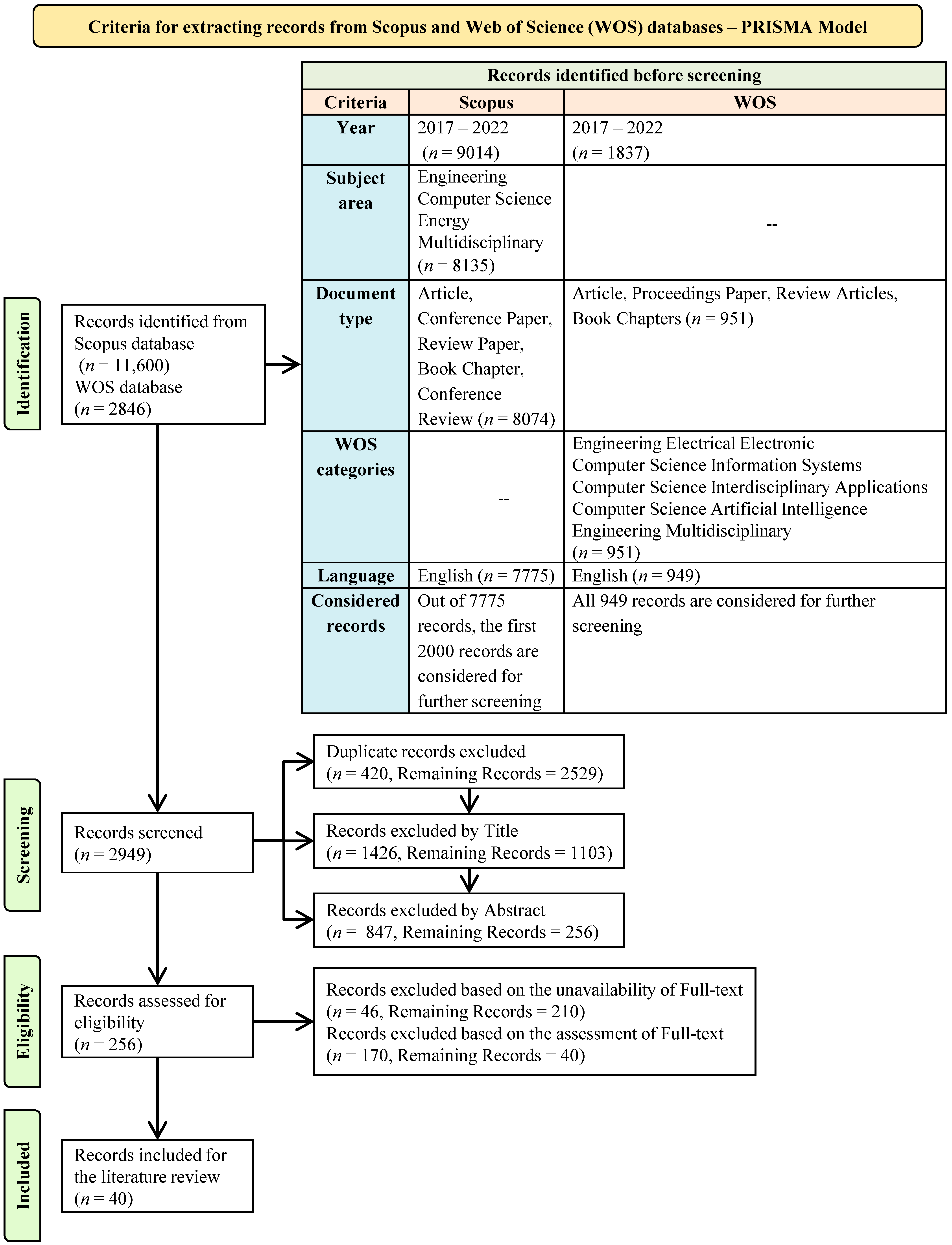
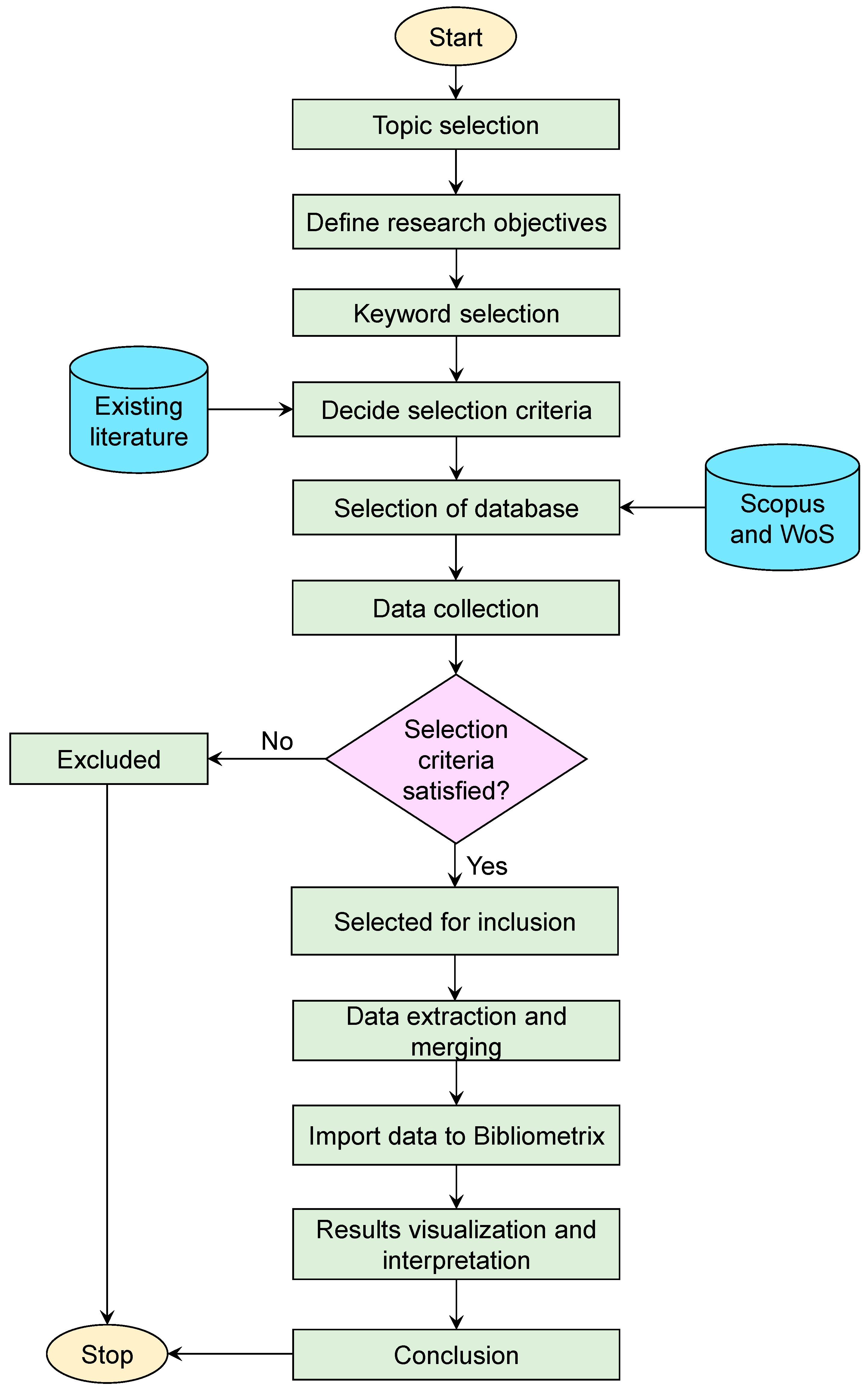
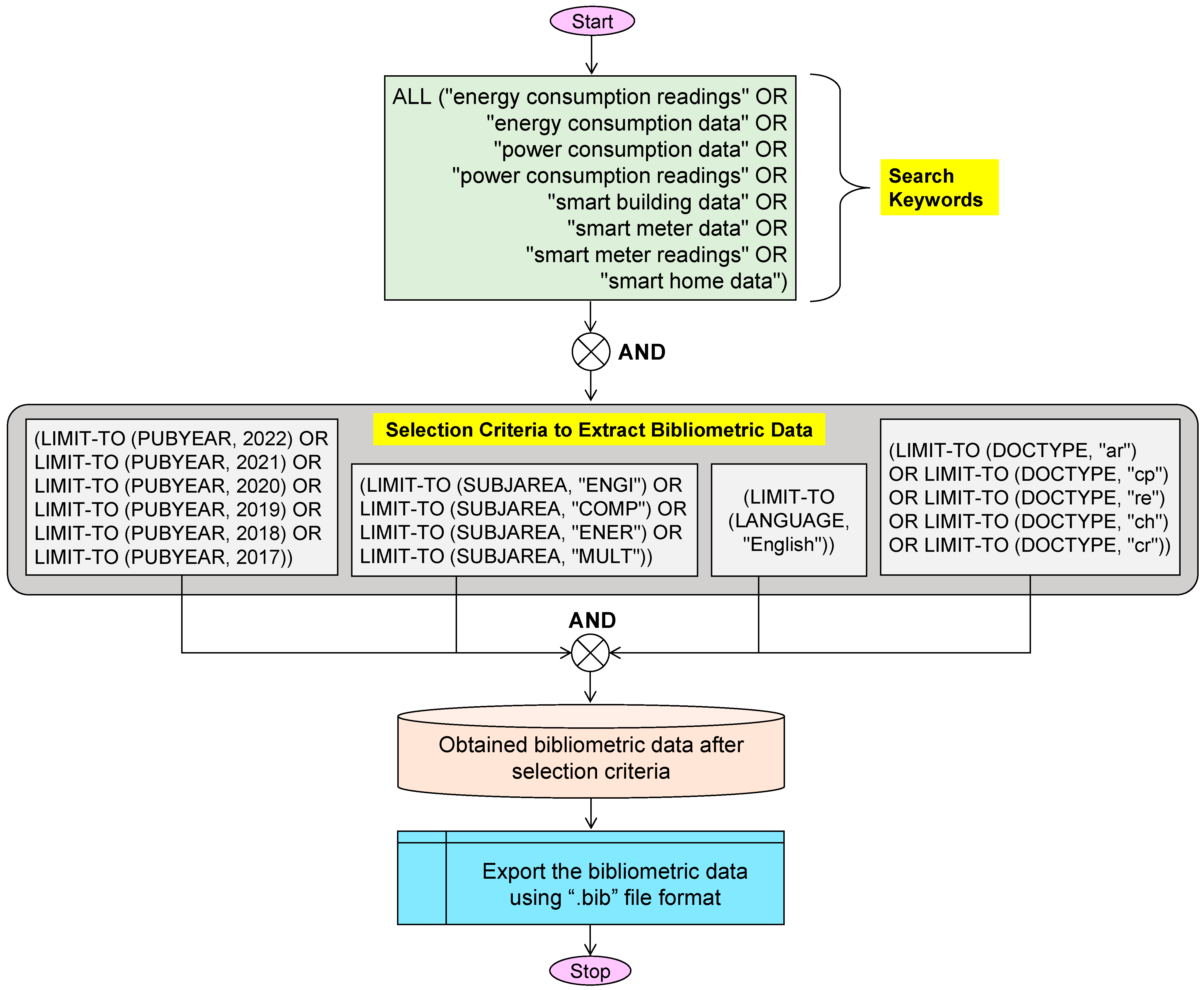
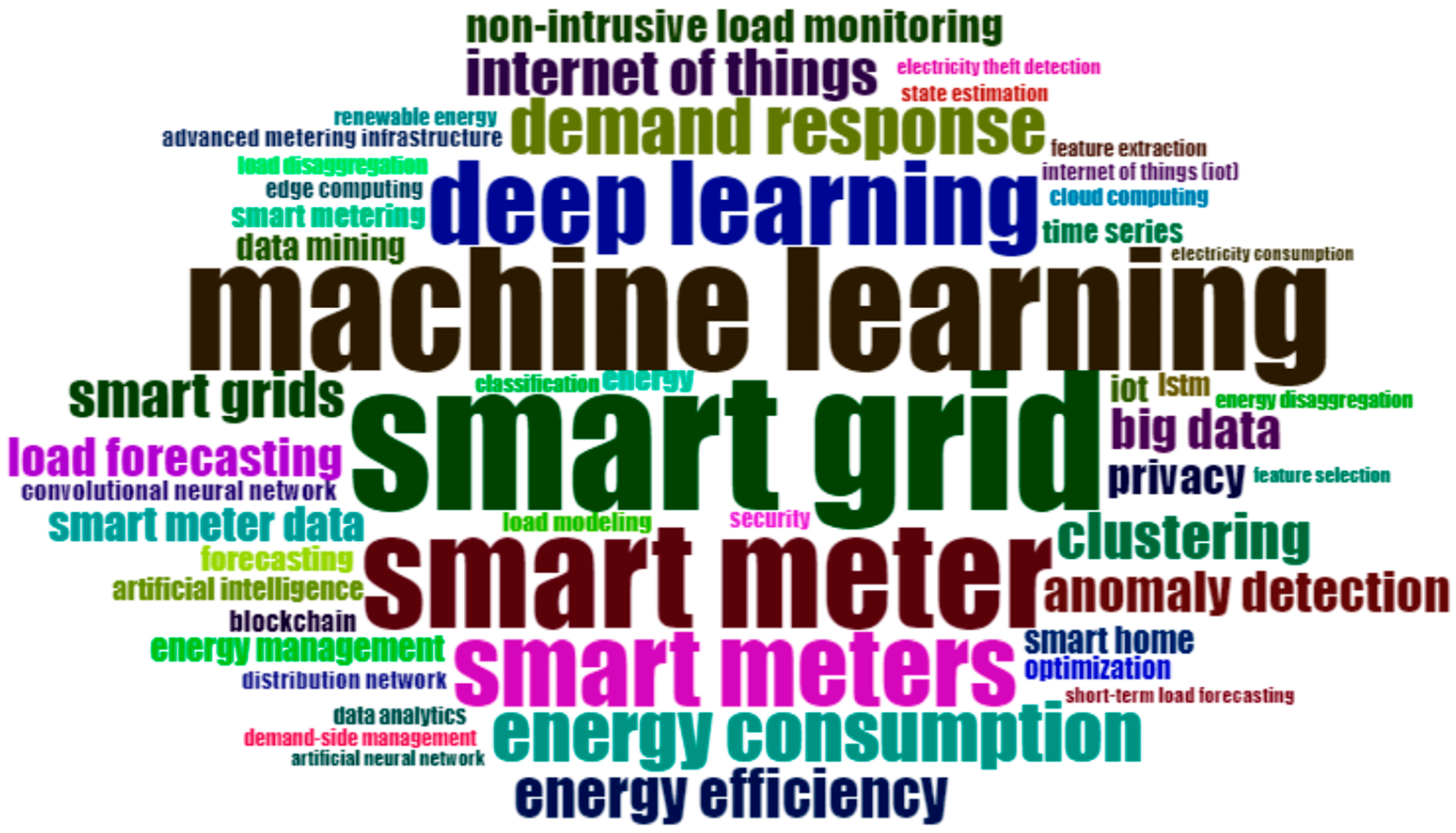
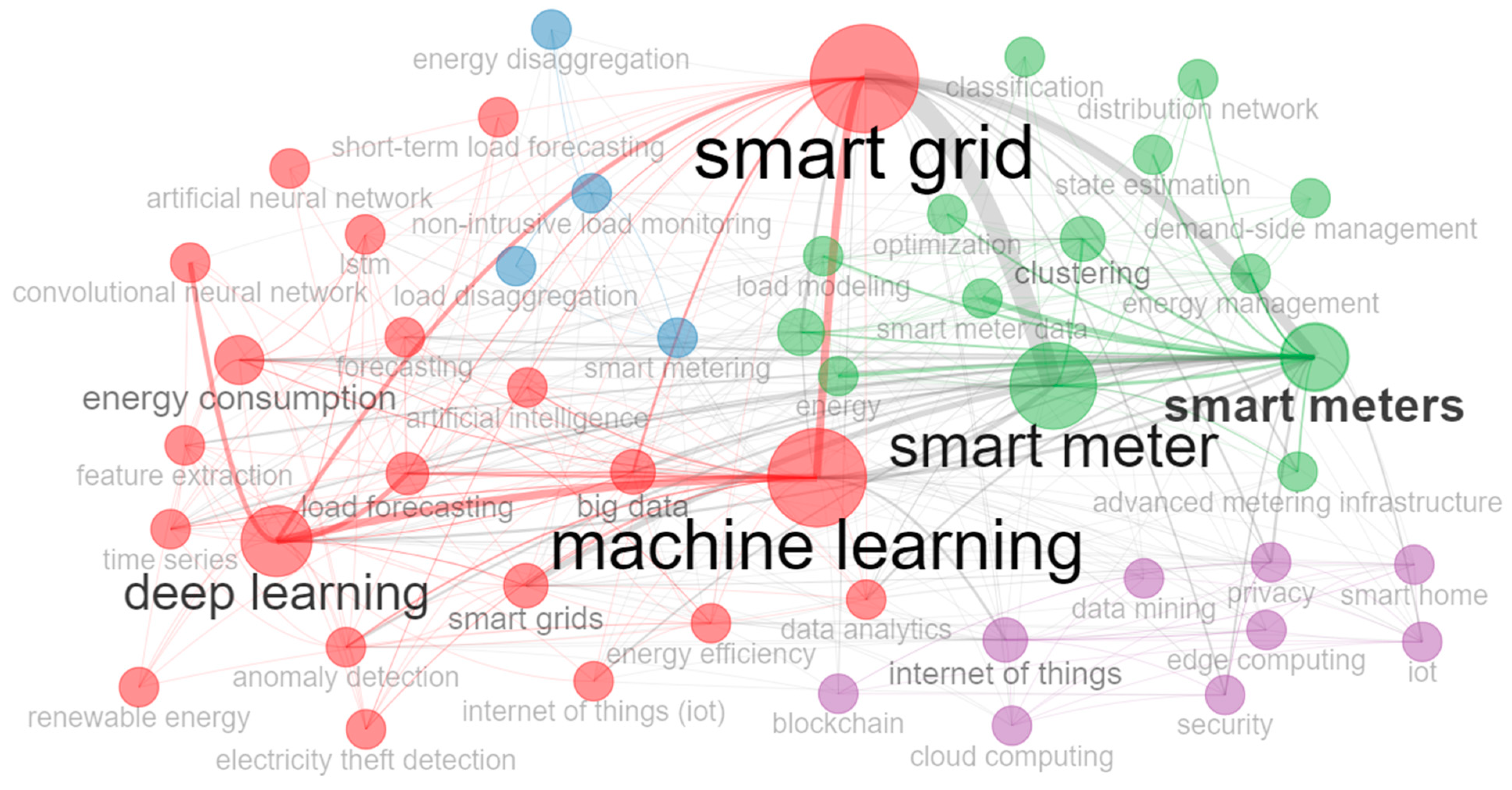
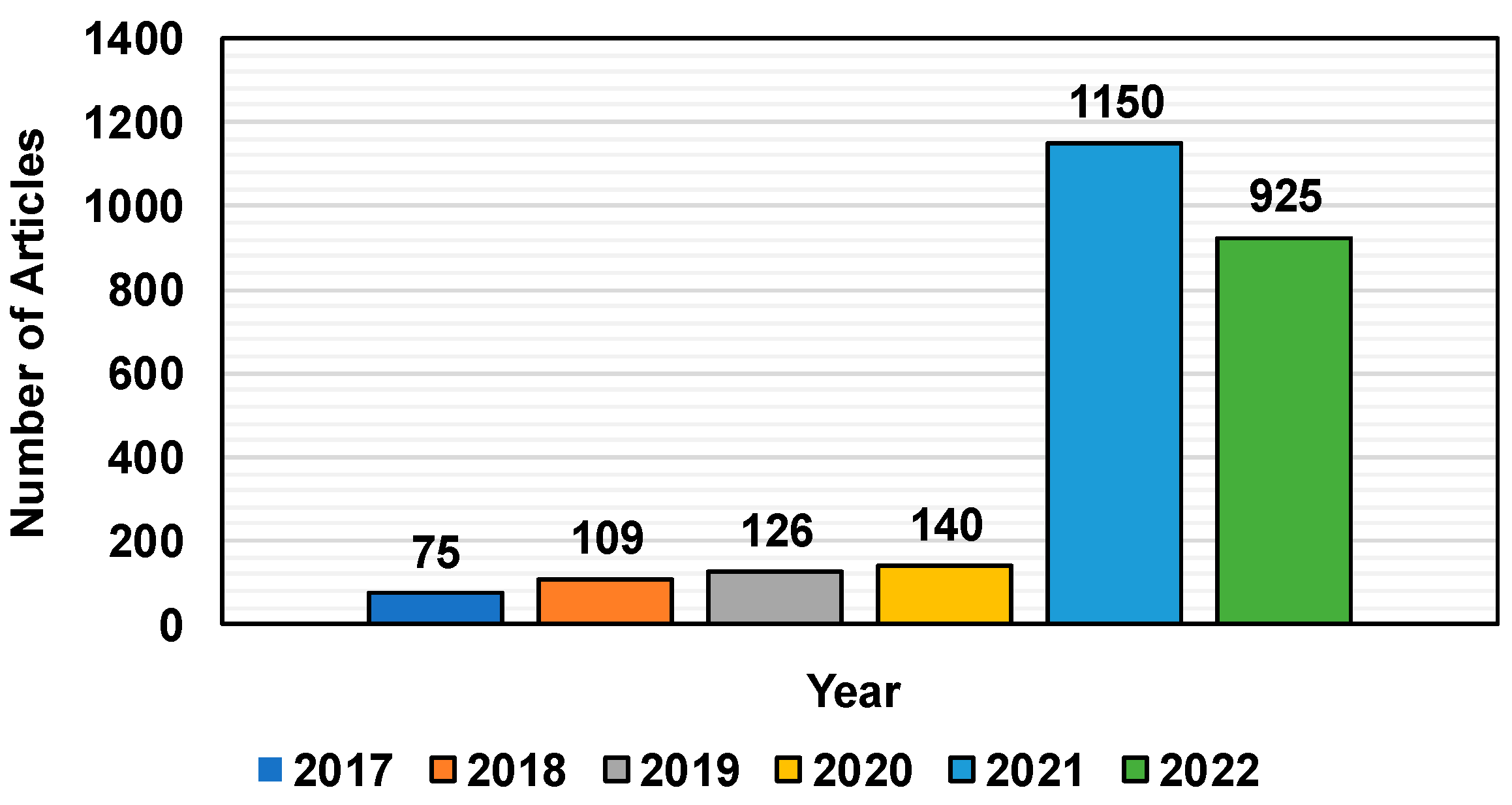


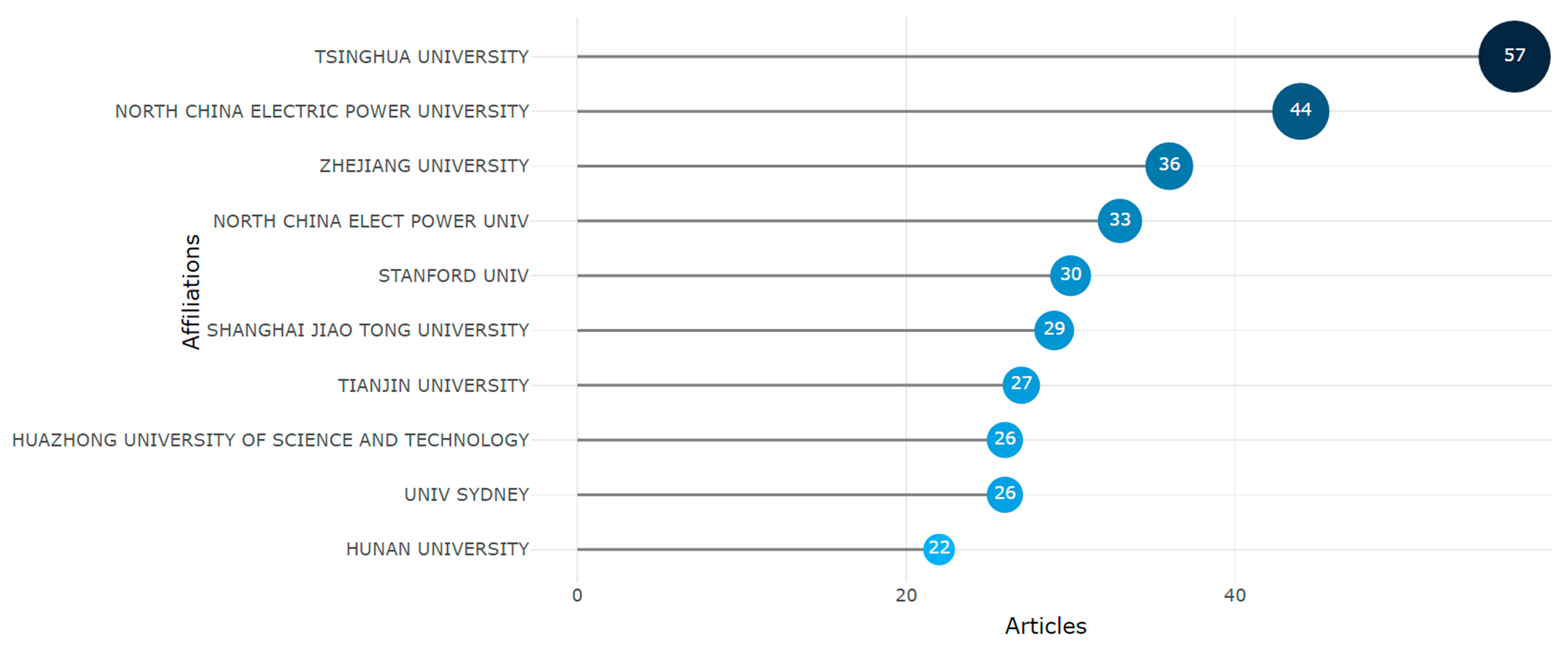
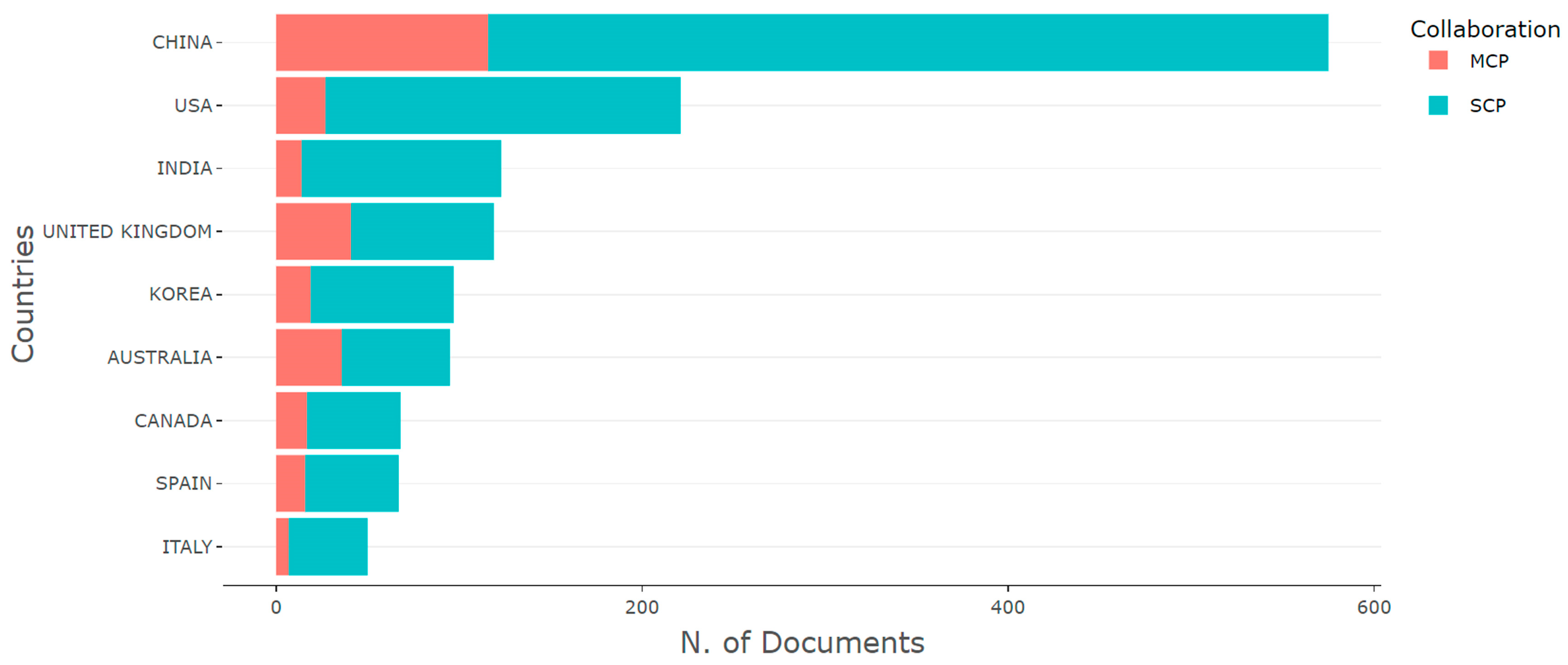


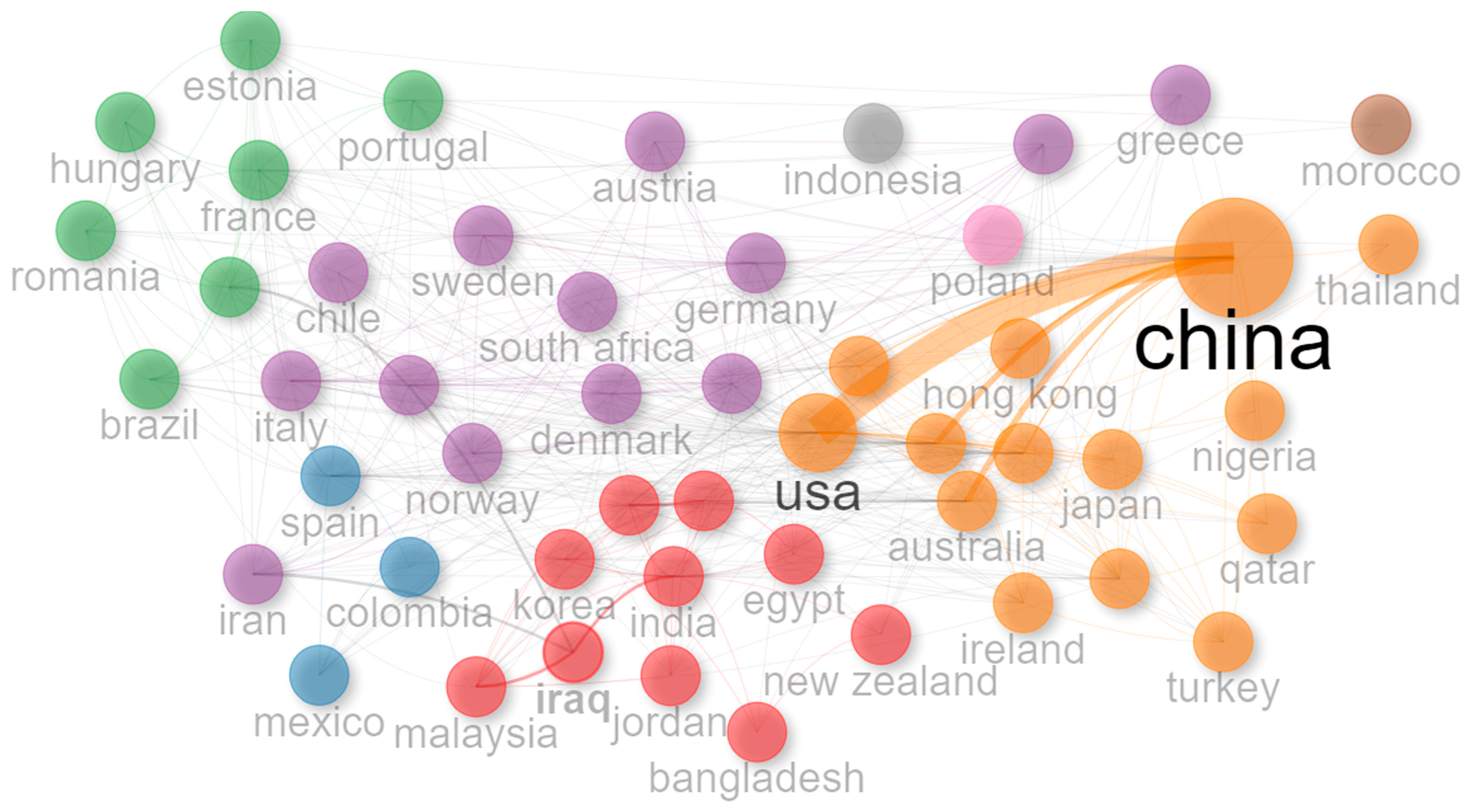
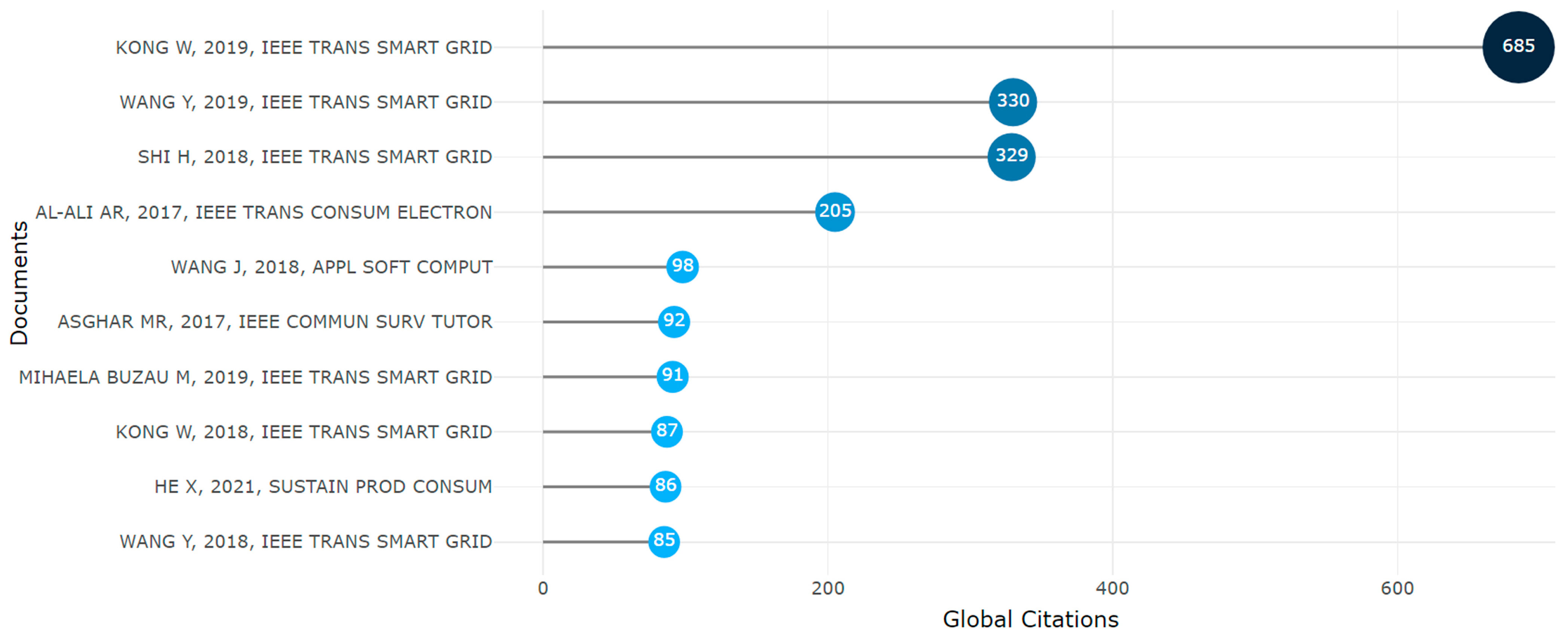
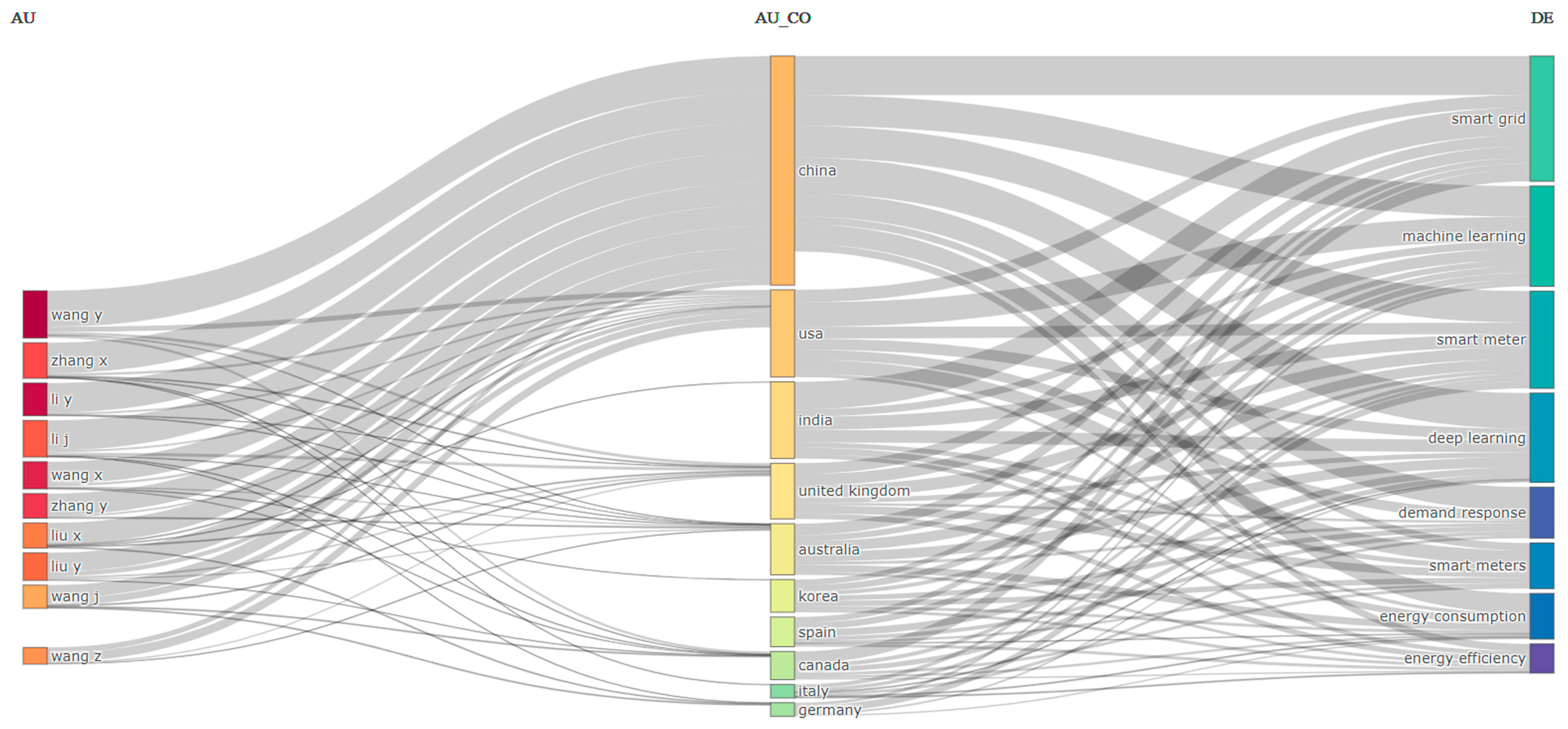
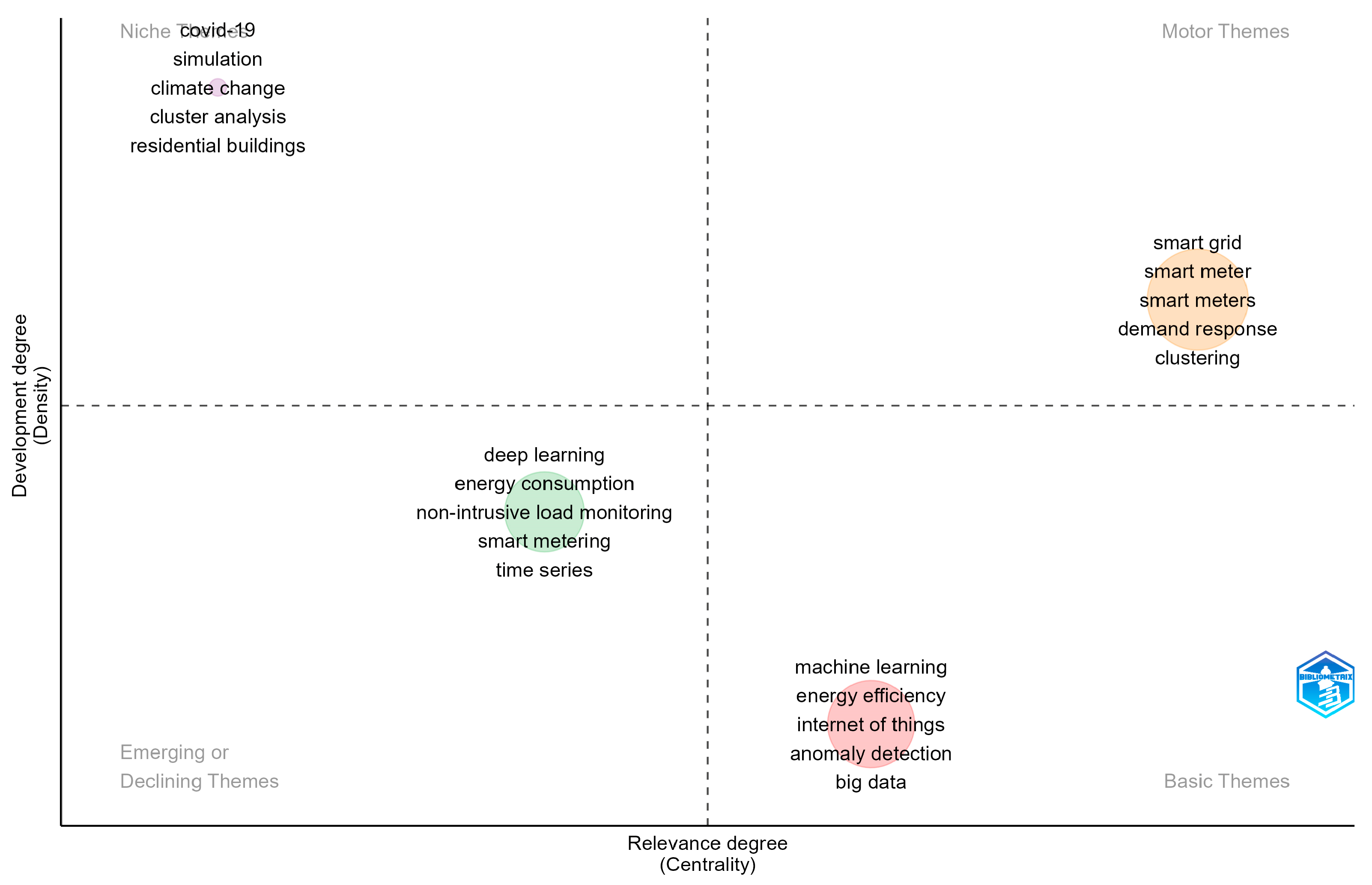
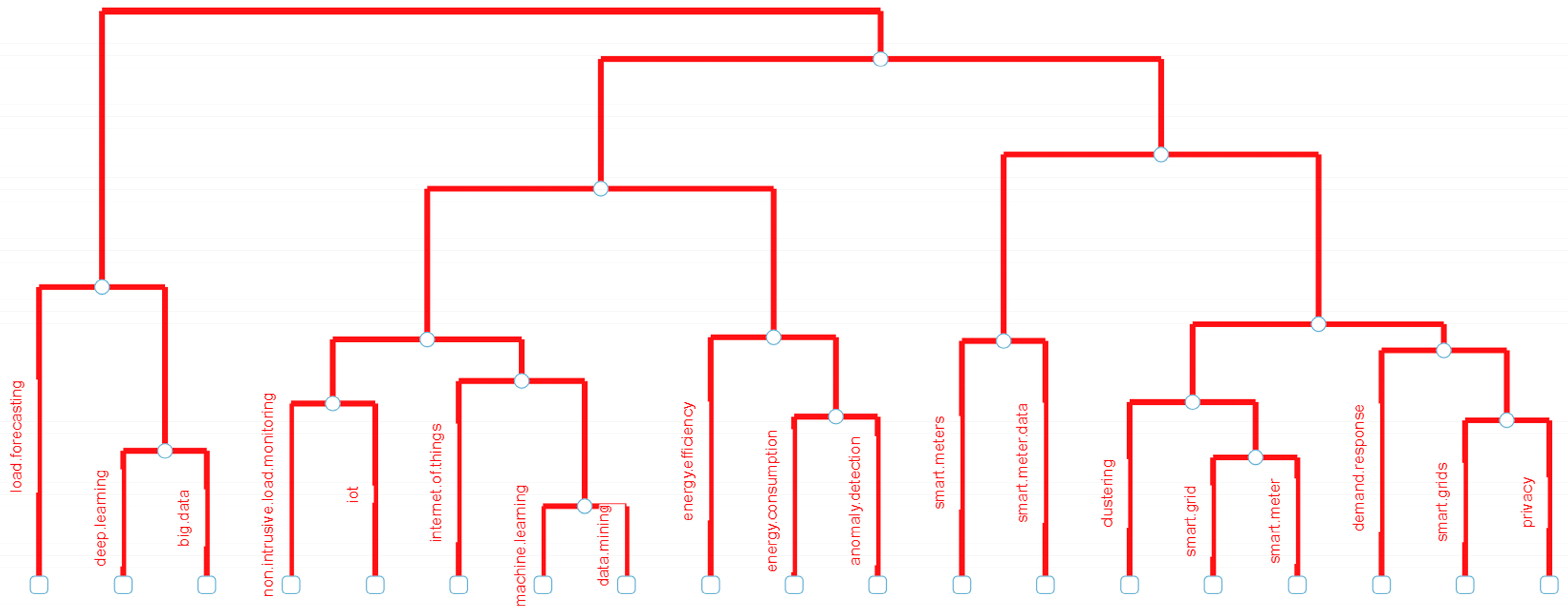
| Year | Key Concept | Literature Works Carried Out | Ref. |
|---|---|---|---|
| 2022 | Data anomalies | A systematic analysis was conducted to enumerate the duplicate records in the energy consumption data of smart buildings | [4] |
| 2022 | A systematic analysis was conducted to identify the behavior of redundancy in smart home power consumption | [5] | |
| 2022 | A systematic three-step method was conducted to learn the abnormal records in smart home power consumption | [6] | |
| 2022 | Machine learning-based techniques were implemented to handle various data anomalies in smart home power consumption | [7] | |
| 2021 | The missing-reading information in smart home power consumption was detected by implementing an effective and easy approach | [8] | |
| 2021 | Energy consumption behavior | Identification of the hidden patterns and anomalies in smart home power consumption was accomplished by executing a framework | [9] |
| 2020 | To comprehend the energy requirement of customers, a framework relying on machine learning was realized on smart meter data | [10] | |
| 2021 | Forecasting energy consumption | To predict the energy utilization statistics in smart buildings, a deep learning-based hybrid model was executed | [11] |
| 2019 | To gather the details of energy utilization in individual residential buildings, a convolutional neural network (CNN) and long short-term memory (LSTM) based model was implemented | [12] | |
| 2019 | A detailed review of conventional and artificial intelligence (AI- based models was performed to forecast energy consumption | [13] | |
| 2021 | Load forecasting | An online adaptive recurrent neural network (RNN) method was applied for load forecasting | [14] |
| 2021 | To estimate short-term loads, time-series forecasting was suggested. Further, a business case was presented for analyzing various clusters to comprehend the behavior of consumers | [15] | |
| 2019 | To address challenges and analyze smart meter data, a clustering-based approach was executed to achieve productive demand-side management and load forecasting | [16] | |
| 2019 | To forecast short-term loads, a framework relying on LSTM-RNN was recommended | [17] | |
| 2018 | To anticipate the load profiles of residential consumers, a pooling-based deep RNN was executed | [18] | |
| 2020 | Internet of Things (IoT) | A smart meter with IoT technology was discussed to cope with the challenges in the smart grid environment | [19] |
| 2019 | A broad review was conducted on the feasibility of employing advanced metering infrastructure (AMI) and smart meter technologies in smart grids for reliable monitoring and better power quality | [20] | |
| 2021 | Non-intrusive load monitoring (NILM) | A deep learning (DL)-based multitask learning approach was executed for NILM in smart meter data | [21] |
| 2019 | To detect the appliance usage and their patterns, a new NILM approach was implemented to find the appliance utilization patterns for better load identification and estimation | [22] | |
| 2018 | To realize the appliances’ status in a network, a voltage–current (V-I) trajectory-based NILM algorithm was implemented | [23] | |
| 2018 | For load profile disaggregation, a novel framework based on “segmented integer quadratic constraint programming” and “hidden Markov models” was discussed | [24] | |
| 2021 | Smart meters and smart meter data | A robust, reliable, and ML-based advanced infrastructure was discussed to investigate and observe smart meter data and further provide enhanced security to smart meters | [25] |
| 2021 | Several applications were discussed for monitoring and protecting distribution systems with the participation of smart meters | [26] | |
| 2021 | An algorithm was implemented to disaggregate household solar energy consumption by reducing the parameters of smart meter data | [27] | |
| 2020 | A scalable strategy was discussed using smart meter data for targeting residential consumers to be part of energy efficiency programs that, in turn, reduce consumption | [28] | |
| 2019 | To sense the non-technical losses in the utilities, a methodology based on analyzing consumers’ behavior with the contribution of supervised learning methods on real-time smart meter data was discussed | [29] | |
| 2017 | A sparse representation approach was presented to reduce voluminous smart meter data and further extract unseen patterns in energy consumption data | [30] | |
| 2021 | Smart home reasoning systems | A methodical literature review was performed to study the characteristics, applications, and challenges of smart home reasoning systems | [31] |
| 2020 | Smart buildings | A CNN model was implemented to calculate building occupancy in real-time by using AMI data | [32] |
| 2021 | Smart grids | A study was performed to learn the developments and the challenges involved in the implementation of DL technologies in smart grid systems | [33] |
| 2021 | Two models, viz. sampling approach and AlexNet, were realized to detect the abstraction of electricity in smart grids | [34] | |
| 2021 | A thorough survey was performed on the implementation of blockchain technology in smart grids to secure them from the cyber world | [35] | |
| 2020 | A comprehensive survey was conducted to learn the opportunities, developments, and future directions of smart grid technologies | [36] | |
| 2020 | The significance and difficulties of big-data analytics in forthcoming power grids were discoursed to guide the researchers | [37] | |
| 2019 | A detailed survey was performed on the problems of privacy and security in smart grid networks | [38] | |
| 2019 | A wide-ranging survey was performed on the security issues of AMI and key safeguarding mechanisms in the smart grid | [39] | |
| 2021 | Renewable energy integration | A broad review was carried out on the practice of AI in assimilating variable renewable energy resources with the power systems by reducing the integration costs | [40] |
| Extraction Process Steps |
|---|
|
| Topics | Titles Count |
|---|---|
| Energy Consumption Readings |Energy Consumption Data | 26 |
| Power Consumption Readings|Power Consumption Data | 12 |
| Smart Meter Readings|Smart Meter Data | 107 |
| Smart Home Data | 10 |
| Smart Building Data | 1 |
| Smart Grid Data | 4 |
| Big Data|Data Analytics|Big Data Analytics|Data Analysis | 69 |
| Machine Learning | 92 |
| Data Issues|Data Anomalies|Abnormal| Abnormalities|Abnormal Behavior|Abnormal Behavior | 19 |
| Energy Consumption Behavior|Energy Consumption Behavior|Consumer Behavior|Customer Behavior|Consumer Behavior|Customer Behavior | 1 |
| Energy Consumption | 190 |
| Forecasting Energy Consumption | 2 |
| Energy Sharing|Energy-Sharing | 1 |
| Appliance Scheduling | 1 |
| Load Scheduling | 4 |
| Load Forecasting | 106 |
| Load Profiling | 5 |
| Internet of Things|IoT|IoT | 48 |
| Non-Intrusive Load Monitoring|NILM | 42 |
| Smart Home Technologies | 1 |
| Communication | 31 |
| Electricity Theft | 39 |
| Renewable Energy | 17 |
| Total Count | 828 |
Disclaimer/Publisher’s Note: The statements, opinions and data contained in all publications are solely those of the individual author(s) and contributor(s) and not of MDPI and/or the editor(s). MDPI and/or the editor(s) disclaim responsibility for any injury to people or property resulting from any ideas, methods, instructions or products referred to in the content. |
© 2024 by the authors. Licensee MDPI, Basel, Switzerland. This article is an open access article distributed under the terms and conditions of the Creative Commons Attribution (CC BY) license (https://creativecommons.org/licenses/by/4.0/).
Share and Cite
Purna Prakash, K.; Venkata Pavan Kumar, Y.; Himajyothi, K.; Pradeep Reddy, G. Comprehensive Bibliometric Analysis on Smart Grids: Key Concepts and Research Trends. Electricity 2024, 5, 75-92. https://doi.org/10.3390/electricity5010005
Purna Prakash K, Venkata Pavan Kumar Y, Himajyothi K, Pradeep Reddy G. Comprehensive Bibliometric Analysis on Smart Grids: Key Concepts and Research Trends. Electricity. 2024; 5(1):75-92. https://doi.org/10.3390/electricity5010005
Chicago/Turabian StylePurna Prakash, Kasaraneni, Yellapragada Venkata Pavan Kumar, Kasaraneni Himajyothi, and Gogulamudi Pradeep Reddy. 2024. "Comprehensive Bibliometric Analysis on Smart Grids: Key Concepts and Research Trends" Electricity 5, no. 1: 75-92. https://doi.org/10.3390/electricity5010005









